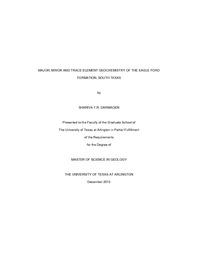
ATTENTION: The works hosted here are being migrated to a new repository that will consolidate resources, improve discoverability, and better show UTA's research impact on the global community. We will update authors as the migration progresses. Please see MavMatrix for more information.
Show simple item record
| dc.contributor.author | Darmaoen, Shariva T.R. | |
| dc.date.accessioned | 2017-05-31T19:20:48Z | |
| dc.date.available | 2017-05-31T19:20:48Z | |
| dc.date.submitted | January 2013 | |
| dc.identifier.other | DISS-12429 | |
| dc.identifier.uri | http://hdl.handle.net/10106/26656 | |
| dc.description.abstract | Major, minor and trace element concentrations analyzed through hand-held ED-XRF and several laboratory techniques characterize geochemical heterogeneity in strata that appear homogeneous within the Eagle Ford Formation. Two major facies were discovered in the study area; one that is rich in carbonates toward the southwest and another that increases in clay minerals toward the northeast. Both facies are enriched in proxies of micronutrients for planktonic organisms. Nutrients precipitated by two possible mechanisms; volcanic input or nutrient cycling from Large Igneous Provinces through upwelling of bottom waters. The provenance indicating rare earth element pattern for both facies deviate from average shale (i.e., average upper continental crust). Elemental data show a combined felsic to mafic source character and imply that volcanism was continuous throughout Eagle Ford time, affecting paleoredox conditions. The Eagle Ford was largely deposited under an anoxic bottom water column, yet cyclical redox variations mirrored changing bottom water column conditions. | |
| dc.description.sponsorship | Basu, Asish | |
| dc.language.iso | en | |
| dc.publisher | Geology | |
| dc.title | Major, Minor And Trace Element Geochemistry Of The Eagle Ford Formation, South Texas | |
| dc.type | M.S. | |
| dc.contributor.committeeChair | Basu, Asish R. | |
| dc.degree.department | Geology | |
| dc.degree.discipline | Geology | |
| dc.degree.grantor | University of Texas at Arlington | |
| dc.degree.level | masters | |
| dc.degree.name | M.S. | |
Files in this item
- Name:
- Darmaoen_uta_2502M_12429.pdf
- Size:
- 34.96Mb
- Format:
- PDF
This item appears in the following Collection(s)
Show simple item record


